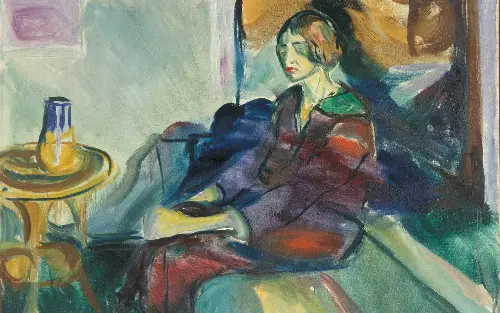
It’s hard to get excited about this exhibition of only 45 pictures against aubergine-purple walls on the second floor of the National Portrait Gallery. The premise is straightforward, and at least provides a coherent, look-again argument: by focusing (for the first time in Britain) on his portraiture, rather than better-known images of vampiric femmes fatales and screaming ghouls beneath apocalyptic skies, the show presents another, less angsty, side of the Norwegian painter Edvard Munch (1863-1944). An artist whose name has become a byword for the alienating effect of modern life is revealed to be more sociable, even cheerful, than previously thought.
Yet, by blanching Munch of strangeness, and straightening out the kinks, the approach risks muting the artist of The Scream (1893). There are too many full-length portraits of respectable, moustachioed men, dressed in sober suits and shiny shoes, and made, as a label puts it, to appear “authoritative” and “masterful”; the four sections are glutted with waistcoats and watch chains, cigars and cravats. The fact that several graphic works are minor (such as a suite depicting the family of Max Linde, one of Munch’s collectors) doesn’t help.
The presiding notion – that Munch was a “social being”, rather than an “outsider” – seems at odds with his artistic aims. Yes, he hung out with bohemians, some of whom he portrayed. Sure, he was plugged into a “network” of patrons and collectors; no man is an island, after all. Yet, in his work – which, on this evidence, was obsessed with mortality from the off – he often returned to a theme of isolation.
Solitary floating heads are a motif: in a 1902 lithograph, the playwright Henrik Ibsen appears like an obese will-o’-the-wisp against a black abyss, entirely cut off from the swirl of everyday café life visible elsewhere in the composition.
Evening (1888) depicts the artist’s mentally ill sister, Laura, wearing a conical straw hat while sitting outside a coastal house, and gazing fixedly ahead, as if consumed by inner torment. Munch even painted out a woman whose ghostly form may still be seen in the middle of the picture to emphasise his sibling’s detachment.
When he did tackle groups, he sometimes resorted to caricature. The figures in a smoke-wreathed Oslo café in his etching Kristiania Bohemians II (1895) have a cartoonish quality, like characters in The Addams Family.
Of course (given that, well, this is Munch!), the exhibition contains scintillating pictures. He didn’t produce many portraits of women, but a fiery 1907 painting of two siblings, Olga and Rosa Meissner, in which the left-hand sister appears to be wearing a sun-scorched mask, like a participant in some ancient pagan ritual, is animated by a strong and uncanny doubling effect.
Aspects of a late painting of Henriette Olsen, the wife of a Norwegian ship-owner and important patron, are unsuccessful (an awkward sense of amputated arms; aimless, decorative leaf-work in the pale-yellow background, an uninspired solution to differentiate the figure); but the treatment of her translucent dandelion-coloured sundress is delightful.
Several portraits are irradiated by conflagrations of flickering colour including one of a doctor who’d treated Munch in a private clinic in Copenhagen, and who, when he saw the likeness produced by his patient, supposedly said: “It’s stark raving mad.” At risk, though, of sounding insensitive, this show feels, as it were, too sane – which produces dissonance: its message, and Munch’s artistic DNA, don’t seem to align.
From March 13; npg.org.uk